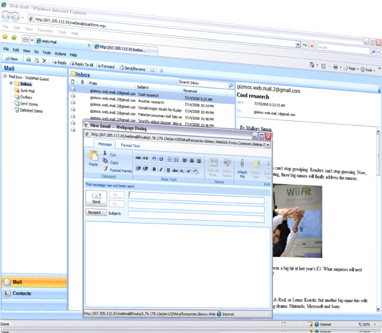 Faster development of a rich media experience for web applications that are secure in operation has been a particularly elusive goal for many enterprise application developers since the debate about thin client and thick clients a decade ago. Until now.
Faster development of a rich media experience for web applications that are secure in operation has been a particularly elusive goal for many enterprise application developers since the debate about thin client and thick clients a decade ago. Until now.
An Israeli company, Gizmox, has followed an interesting path to develop its technologies and business model. Founded in a garage in 2005 and formally established in 2007, the company has raised $3.5 million in VC funding and achieved some 370,000 downloads and 35,000 applications demonstrating Visual WebGui’s solid following as an open source project.
Now, the company introduces a commercial support and licensing scheme as it seeks to further penetrate the enterprise market. Visual WebGui brings the ultimate simplicity to the .NET development framework through an enterprise SDK ($1,500/seat/year) that plugs into popular development tools such as Windows Forms or for the Java developer – Swing. The runtime server product ($3,000/server/year) acts as a web interface to the application and supports DHTML, Silverlight and other presentation standards.
The Empty Client
To the first-time user, the browser kernel is a small footprint (250 kb) and is downloaded once – content updates and user interactions are send as AJAX and XML messages. All standard browsers are supported (IE, Firefox, Safari, Opera, Netscape, Chrome) including the Microsoft Starlight browser. The company plans to enable Flash and other mobile web environments as market and customer demand warrants.
More Secure. So, since there is no business process logic stored in the client and only a generic message processor is activated in the browser, all the classic issues relating to client control are minimized since the server does all the heavy lifting. No sensitive application data, business or UI logic is stored in the client. Gizmox has pushed this claim a little farther than most in that they recently offered a $10,000 prize if anyone could hack the implementation. No prizes were awarded.
Higher Performance. Three unique attributes really make this architecture higher performance in delivering the user experience of a rich media application. Using the unique communications protocol where any packet never exceeds 1 kb, assures that client-server chattiness is not an issue. The environment also maintains a reliably constant server state minimizing server CPU loads. Finally, since the initial operations step is a qualification of the browser providing the server with insights about the rendering engines, device capabilities and browsers-in-service, the user experience is more easily and automatically optimized.
Rich media applications can be constructed using Microsoft development tools such as Visual Studio 2008 where the Visual WebGui has been integrated through templates. Check out this demo.
 Probably the most compelling demonstration of Visual WebGui’s power is the company’s demo of Microsoft Outlook for Web. Usually, the webmail interface into an enterprise Exchange server is pretty dull and feature-poor.
Probably the most compelling demonstration of Visual WebGui’s power is the company’s demo of Microsoft Outlook for Web. Usually, the webmail interface into an enterprise Exchange server is pretty dull and feature-poor.
Microsoft does this primarily because they would prefer customers to use the Outlook client. The webmail window is meant only as a last resort and is probably included in the Exchange sale so they can get the proverbial check in the box for webmail support.
Gizmox has taken their implementation of Visual WebGui server and development toolkit and about 1 developer’s effort for a month to more cleanly emulate the Outlook client within the browser.
There should be no doubt that with the interest in cloud computing services and user preferences for rich media applications running on a wider variety of platforms will only exacerbate the concerns about security of enterprise data and the cost of multiple device support which plays well to the Visual WebGui advantage in the marketplace.






